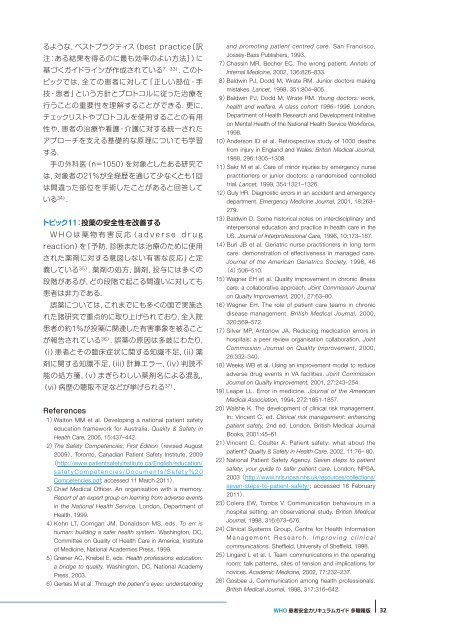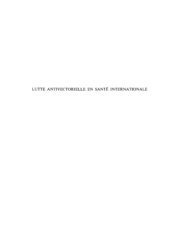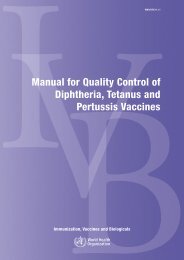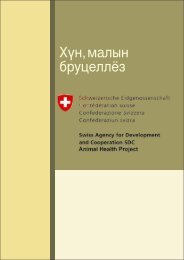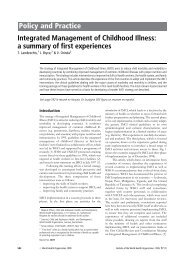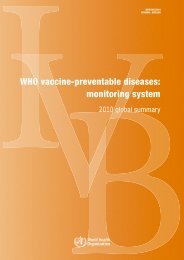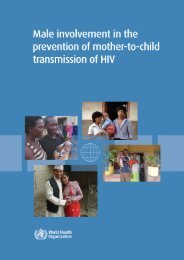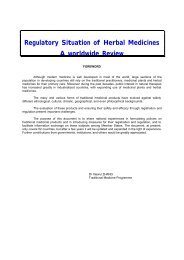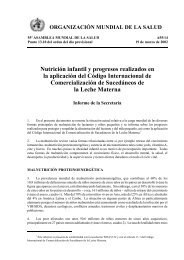WHO Patient Safety Curriculum Guide - Extranet Systems - World ...
WHO Patient Safety Curriculum Guide - Extranet Systems - World ...
WHO Patient Safety Curriculum Guide - Extranet Systems - World ...
You also want an ePaper? Increase the reach of your titles
YUMPU automatically turns print PDFs into web optimized ePapers that Google loves.
るような,ベストプラクティス(best practice[ 訳<br />
注 :ある 結 果 を 得 るのに 最 も 効 率 のよい 方 法 ])に<br />
基 づくガイドラインが 作 成 されている 7, 33) .こ の ト<br />
ピックでは, 全 ての 患 者 に 対 して「 正 しい 部 位 ・ 手<br />
技 ・ 患 者 」という 方 針 とプロトコルに 従 った 治 療 を<br />
行 うことの 重 要 性 を 理 解 することができる. 更 に,<br />
チェックリストやプロトコルを 使 用 することの 有 用<br />
性 や, 患 者 の 治 療 や 看 護 ・ 介 護 に 対 する 統 一 された<br />
アプローチを 支 える 基 礎 的 な 原 理 についても 学 習<br />
する.<br />
手 の 外 科 医 (n=1050)を 対 象 としたある 研 究 で<br />
は, 対 象 者 の21%が 全 経 歴 を 通 じて 少 なくとも1 回<br />
は 間 違 った 部 位 を 手 術 したことがあると 回 答 して<br />
いる 34) .<br />
トピック11: 投 薬 の 安 全 性 を 改 善 する<br />
<strong>WHO</strong>は 薬 物 有 害 反 応 (adverse d rug<br />
reaction)を「 予 防 , 診 断 または 治 療 のために 使 用<br />
された 薬 剤 に 対 する 意 図 しない 有 害 な 反 応 」と 定<br />
義 している 35) . 薬 剤 の 処 方 , 調 剤 , 投 与 には 多 くの<br />
段 階 があるが,どの 段 階 で 起 こる 間 違 いに 対 しても<br />
患 者 は 非 力 である.<br />
誤 薬 については,これまでにも 多 くの 国 で 実 施 さ<br />
れた 諸 研 究 で 重 点 的 に 取 り 上 げられており, 全 入 院<br />
患 者 の 約 1%が 投 薬 に 関 連 した 有 害 事 象 を 被 ること<br />
が 報 告 されている 36) . 誤 薬 の 原 因 は 多 岐 にわたり,<br />
(i) 患 者 とその 臨 床 症 状 に 関 する 知 識 不 足 ,(ii) 薬<br />
剤 に 関 する 知 識 不 足 ,(iii) 計 算 エラー,(iv) 判 読 不<br />
能 の 処 方 箋 ,(v)まぎらわしい 薬 剤 名 による 混 乱 ,<br />
(vi) 病 歴 の 聴 取 不 足 などが 挙 げられる 37) .<br />
References<br />
1Walton MM et al. Developing a national patient safety<br />
education framework for Australia. Quality & <strong>Safety</strong> in<br />
Health Care, 2006, 15:437–442.<br />
2The <strong>Safety</strong> Competencies, First Edition revised August<br />
2009. Toronto, Canadian <strong>Patient</strong> <strong>Safety</strong> Institute, 2009<br />
http://www.patientsafetyinstitute.ca/English/education/<br />
safetyCompetencies/Documents/<strong>Safety</strong> 2 0<br />
Competencies.pdf; accessed 11 March 2011.<br />
3Chief Medical Officer. An organisation with a memory.<br />
Report of an expert group on learning from adverse events<br />
in the National Health Service. London, Department of<br />
Health, 1999.<br />
4Kohn LT, Corrigan JM, Donaldson MS, eds. To err is<br />
human: building a safer health system. Washington, DC,<br />
Committee on Quality of Health Care in America, Institute<br />
of Medicine, National Academies Press, 1999.<br />
5Greiner AC, Knebel E, eds. Health professions education:<br />
a bridge to quality. Washington, DC, National Academy<br />
Press, 2003.<br />
6Gerteis M et al. Through the patients eyes: understanding<br />
and promoting patient centred care. San Francisco,<br />
Jossey-Bass Publishers, 1993.<br />
7Chassin MR, Becher EC. The wrong patient. Annals of<br />
Internal Medicine, 2002, 136:826–833.<br />
8Baldwin PJ, Dodd M, Wrate RM. Junior doctors making<br />
mistakes. Lancet, 1998, 351:804–805.<br />
9Baldwin PJ, Dodd M, Wrate RM. Young doctors: work,<br />
health and welfare. A class cohort 1986–1996. London,<br />
Department of Health Research and Development Initiative<br />
on Mental Health of the National Health Service Workforce,<br />
1998.<br />
10Anderson ID et al. Retrospective study of 1000 deaths<br />
from injury in England and Wales. British Medical Journal,<br />
1988, 296:1305–1308.<br />
11Sakr M et al. Care of minor injuries by emergency nurse<br />
practitioners or junior doctors: a randomised controlled<br />
trial. Lancet, 1999, 354:1321–1326.<br />
12Guly HR. Diagnostic errors in an accident and emergency<br />
department. Emergency Medicine Journal, 2001, 18:263–<br />
279.<br />
13Baldwin D. Some historical notes on interdisciplinary and<br />
interpersonal education and practice in health care in the<br />
US. Journal of Interprofessional Care, 1996, 10:173–187.<br />
14Burl JB et al. Geriatric nurse practitioners in long term<br />
care: demonstration of effectiveness in managed care.<br />
Journal of the American Geriatrics Society, 1998, 46<br />
4:506–510.<br />
15Wagner EH et al. Quality improvement in chronic illness<br />
care: a collaborative approach. Joint Commission Journal<br />
on Quality Improvement, 2001, 27:63–80.<br />
16Wagner EH. The role of patient care teams in chronic<br />
disease management. British Medical Journal, 2000,<br />
320:569–572.<br />
17Silver MP, Antonow JA. Reducing medication errors in<br />
hospitals: a peer review organisation collaboration. Joint<br />
Commission Journal on Quality Improvement, 2000,<br />
26:332–340.<br />
18Weeks WB et al. Using an improvement model to reduce<br />
adverse drug events in VA facilities. Joint Commission<br />
Journal on Quality Improvement, 2001, 27:243–254.<br />
19Leape LL. Error in medicine. Journal of the American<br />
Medical Association, 1994, 272:1851-1857.<br />
20Walshe K. The development of clinical risk management.<br />
In: Vincent C, ed. Clinical risk management: enhancing<br />
patient safety, 2nd ed. London, British Medical Journal<br />
Books, 2001:45–61.<br />
21Vincent C, Coulter A. <strong>Patient</strong> safety: what about the<br />
patient Quality & <strong>Safety</strong> in Health Care, 2002, 11:76– 80.<br />
22National <strong>Patient</strong> <strong>Safety</strong> Agency. Seven steps to patient<br />
safety: your guide to safer patient care. London, NPSA,<br />
2003 http://www.nrls.npsa.nhs.uk/resources/collections/<br />
seven-steps-to-patient-safety/; accessed 16 February<br />
2011.<br />
23Coiera EW, Tombs V. Communication behaviours in a<br />
hospital setting: an observational study. British Medical<br />
Journal, 1998, 316:673–676.<br />
24Clinical <strong>Systems</strong> Group, Centre for Health Information<br />
Management Research. Improving clinical<br />
communications. Sheffield, University of Sheffield, 1998.<br />
25Lingard L et al. I. Team communications in the operating<br />
room: talk patterns, sites of tension and implications for<br />
novices. Academic Medicine, 2002, 77:232–237.<br />
26Gosbee J. Communication among health professionals.<br />
British Medical Journal, 1998, 317:316–642.<br />
<strong>WHO</strong> 患 者 安 全 カリキュラムガイド 多 職 種 版 32


